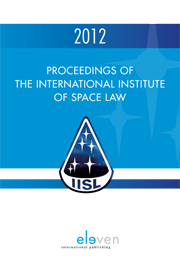|
This paper analyses the interrelationship between science, risk, international law and the prevention of collisions between space objects, so as to contribute to progressive development of international law and of an epistemic community invested with a common conceptual and terminological apparatus, as well as to examine interrelated juridical and technical obstacles and opportunities regarding the creation of an informed, uniform and therefore, it is posited, more effective regulatory regime. |


International Institute of Space Law
About this journalSubscribe to the email alerts for this journal here to receive notifications when a new issue is at your disposal.
| Article |
Space Debris: Between Unity and Fragmentation – Risk as a Static Principle with Dynamic Outcomes |
| Keywords | risk, space object, space debris removal, material environment, social milieu, collision prevention, harmful interference |
| Authors | Ward Munters |
| AbstractAuthor's information |
| Article |
Out into the Dark: Removing Space Debris from the Geostationary Orbit |
| Keywords | Space law, IADC, remediation, active space debris removal, Geostationary Orbit, GEO region, space debris mitigation guidelines, re-orbit guideline, Outer Space Treaty, Liability Convention |
| Authors | Martha Mejía-Kaiser |
| AbstractAuthor's information |
|
During the first decades of placing space objects in the Geostationary Orbit, satellite owners and operators abandoned space objects at their end-of-life, or just freed the slot by removing their satellites with the last kilograms of fuel. Also rocket stages that propelled geostationary satellites were abandoned therein. Due to orbital perturbations at about 36,000 km, objects that do not have station-keeping systems can drift into the slots of neighboring satellites and disturb their operation. Space debris objects at this altitude take at least one million years to naturally de-orbit and re-enter the Earth’s atmosphere. The accumulation of space debris objects that permanently cross the Geostationary Orbit is a growing hazard to operational satellites. Researchers at the IADC who published a set of Space Debris Mitigation Guidelines in 2002, identified the Geostationary Orbit as a ‘protected region’. One Mitigation Guideline recommends to re-orbit space objects that are reaching their end-of-life outside of this protected area. A growing number of States and international organizations reflect the IADC Mitigation Guidelines in national legislation, recommendations and standards. However, there is still an increase of large space debris objects in this area. Since it is not realistic to wait (up to one million years) for the natural deorbiting of these space objects, remediation measures need to be initiated, such as debris removal with external systems. This article describes the State practice of re-orbiting and proposes a strategy for debris removal to maintain a sustainable access and use of the Geostationary Orbit. |
|
My paper advocates for the creation of a legal policy aimed at accelerating the initiation of the “Space Debris Removal Business” as quickly as possible. This policy is focused on government compensation for situations where the damage in outer space exceeds an insured amount. The policy will cover any damage derived from active orbital services, including Space Debris Removal. |
